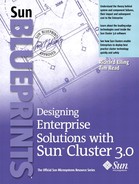Backup-and-Restore Testing
Tape backup of critical systems in a data center is routine. However, tape restores are not a common practice. Often an inadequate backup ends in an incomplete restore process.
Note
A best practice is to routinely schedule tape restore drills to familiarize system administrators with the process and to validate the adequacy of any backup procedure. Tape restore drills help evaluate the time involved to bring mission-critical systems back online—the business impact can be analyzed and reviewed for improvement.
Because the tape medium makes physical contact with the read/write heads on tape drives, it becomes unreliable after a certain number of write cycles. Contact the tape medium manufacturer to determine the best practice for retiring unreliable tapes from the backup pool.
All backup media have an estimated shelf life, which is the time during which the data has a high probability of being reliably readable. This includes all magnetic and optical media, such as disks, tapes, CD-RW, and DVD. For media designed for data archival, the media vendor supplies an estimated lifetime. Typical data archives have very little error recovery capability, and once a small portion of the data is unreadable, the entire archive may be useless. For long-term data storage, the media must be read, verified, and written to new media on a regular schedule.
